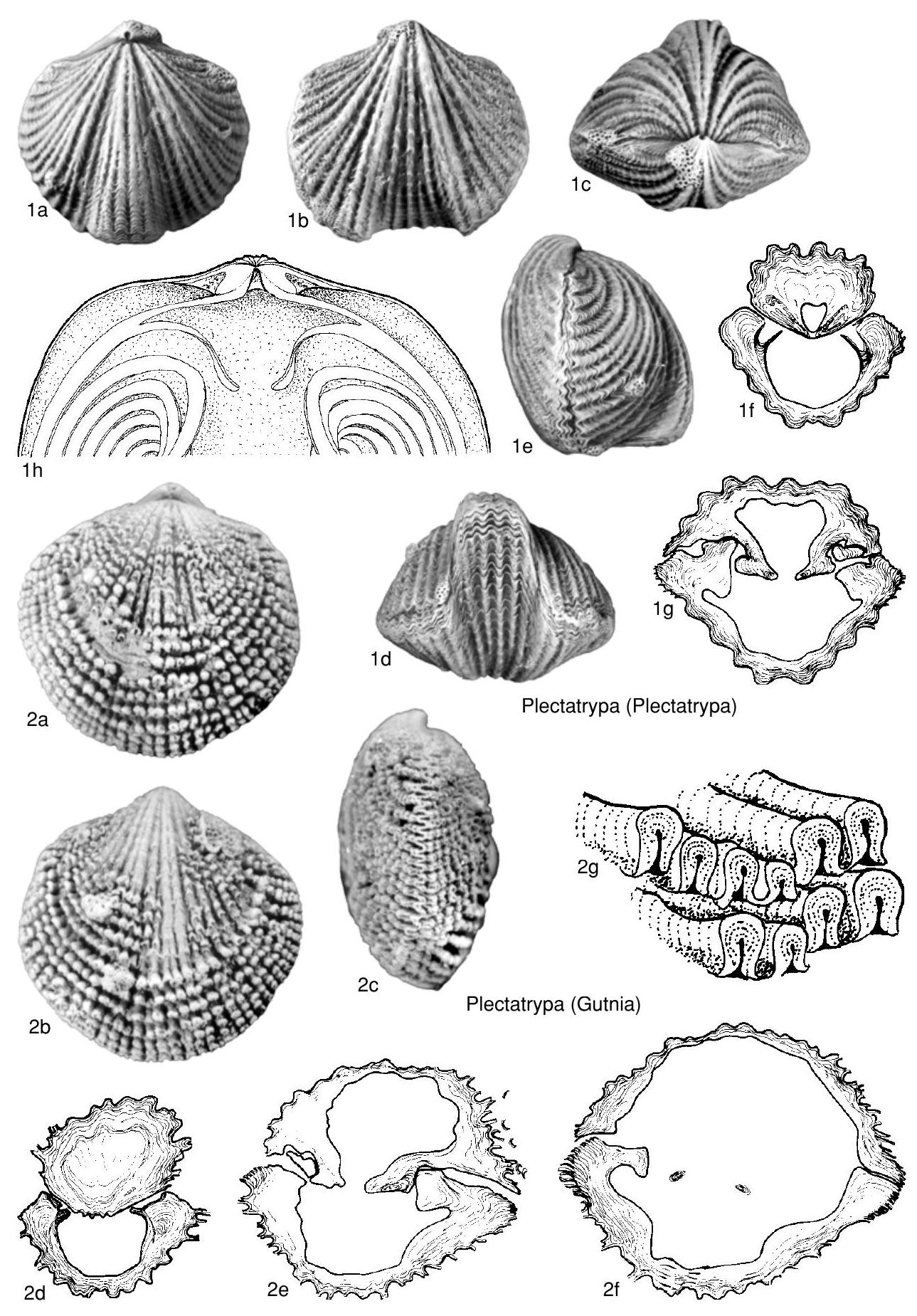Welcome to the Treatise on Invertebrate Paleontology!
Please enter a genera name to retrieve more information.

Plectatrypa
Classification
Phylum:
Brachiopoda
Subphylum:
Rhynchonelliformea
Class:
Rhynchonellata
Order:
Atrypida
Suborder:
Atrypidina
Superfamily:
Atrypoidea
Family:
Atrypinidae
Subfamily:
Plectatrypinae
Formal Genus Name and Reference:
Plectatrypa COOPER, 1930, p. 278
Type Species:
Terebratula imbricata J. de C. SOWERBY, 1839, p. 624, OD
Images
(Click to enlarge in a new window)
Fig. 967, 1h. P. (P.) sp. cf. P. (P.) imbricata, upper Wenlock, Gotland; reconstruction of brachidia, ×4 (new).
Synonyms
Imbricatospira
Geographic Distribution
North America, Eurasia
Age Range
Beginning Stage in Treatise Usage:
Silurian (Llandovery)
Beginning International Stage:
Rhuddanian
Fraction Up In Beginning Stage:
0
Beginning Date:
443.07
Ending Stage in Treatise Usage:
Silurian (Ludlow, ?Pridoli)
Ending International Stage:
Pridoli
Fraction Up In Ending Stage:
100
Ending Date:
419
Description
Small to medium size, rounded, biconvex-dorsibiconvex, small pointed beak, anacline-hypercline area, apical-transapical foramen, deltidial plates normally not exposed, ribs medium to coarse, highly imbricate, with sharply projecting growth lamellae, strongly divergent, enlarged ventral midrib sets separated by wide sulcus, producing carination, strong, U-shaped anterior fold, internally thin to thick shell apically, pedicle callist thin to absent, deltidial plates extended into pedicle cavity as thin lining, teeth short, thick, medially directed, lacking dental cavities, delicate crural bases, fine crura, fewer than 8 dorsomedial, relatively widely spaced spiralial whorls, fine jugal processes curved laterally, terminating in delicate plates. Distinct from Sypharatrypa in rib imbrication, distinct from Xanthea in finer ribs, lack of microornament.
References
Museum or Author Information
Classification
Phylum:
Brachiopoda
Subphylum:
Rhynchonelliformea
Class:
Rhynchonellata
Order:
Atrypida
Suborder:
Atrypidina
Superfamily:
Atrypoidea
Family:
Atrypinidae
Subfamily:
Plectatrypinae
Formal Genus Name and Reference:
Plectatrypa COOPER, 1930, p. 278
Type Species:
Terebratula imbricata J. de C. SOWERBY, 1839, p. 624, OD
Images
(Click to enlarge in a new window)
Fig. 967, 1h. P. (P.) sp. cf. P. (P.) imbricata, upper Wenlock, Gotland; reconstruction of brachidia, ×4 (new).
Synonyms
Imbricatospira
Geographic Distribution
North America, Eurasia
Age Range
Beginning Stage in Treatise Usage:
Silurian (Llandovery)
Beginning International Stage:
Rhuddanian
Fraction Up In Beginning Stage:
0
Beginning Date:
443.07
Ending Stage in Treatise Usage:
Silurian (Ludlow, ?Pridoli)
Ending International Stage:
Pridoli
Fraction Up In Ending Stage:
100
Ending Date:
419
Description
Small to medium size, rounded, biconvex-dorsibiconvex, small pointed beak, anacline-hypercline area, apical-transapical foramen, deltidial plates normally not exposed, ribs medium to coarse, highly imbricate, with sharply projecting growth lamellae, strongly divergent, enlarged ventral midrib sets separated by wide sulcus, producing carination, strong, U-shaped anterior fold, internally thin to thick shell apically, pedicle callist thin to absent, deltidial plates extended into pedicle cavity as thin lining, teeth short, thick, medially directed, lacking dental cavities, delicate crural bases, fine crura, fewer than 8 dorsomedial, relatively widely spaced spiralial whorls, fine jugal processes curved laterally, terminating in delicate plates. Distinct from Sypharatrypa in rib imbrication, distinct from Xanthea in finer ribs, lack of microornament.
